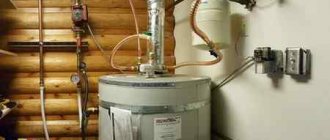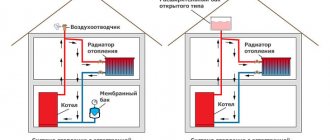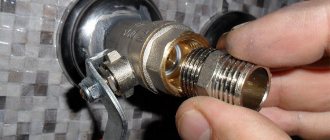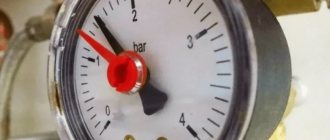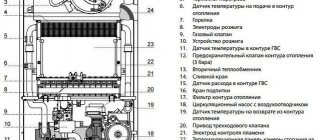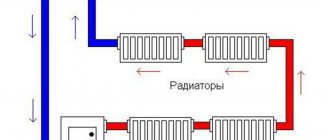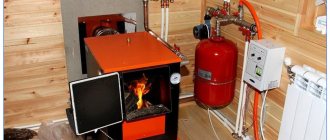The pressure in heating equipment is unstable and changes for various reasons. The readings are displayed on the pressure gauge. A normal reading is 1-2.5 bar. If they are above 3 bar, urgent measures should be taken to reduce the readings. The safety valve will indicate the difference.
It will release water to release excess. In electronically controlled units, such problems are displayed as an error on the display and the boiler will stop operating. In devices without built-in electronics, the difference leads to malfunctions and explosions.
Reasons for increased pressure in case of boiler damage
When cracks appear on the connecting membrane, the expansion tank is not able to smooth out water hammer.
The coolant enters the container without obstacles, the pressure decreases. The pressure gauge readings will increase, and a leak will appear at the joints. The malfunction is eliminated by replacing the membrane or expansion tank.
The pressure in the heating system increases when one of the main components breaks down:
- The value increases when the feed tap is slightly open. A contrast arises between low pressure in the apparatus and increased pressure in the water supply. Water is added to the heating line, as a result of which the pressure in the boiler rises. As the pressure decreases, the coolant blocks the seepage into the boiler, and the values on the pressure gauge decrease. To prevent such surges from occurring, the supply shut-off valves must be closed, and leaking taps must be replaced in a timely manner.
- The reason for the increase in value by 1 atmosphere may be depressurization of the heat exchanger. Leaks on the housing occur as a result of wear and tear during prolonged use of the equipment, due to a manufacturing defect, or due to hydraulic shocks. When the heat exchanger breaks down, water constantly enters the circuit. In places of cracking, the liquid evaporates during heating, so it is difficult to visually track the breakdown, due to which the pressure increases. The malfunction can only be eliminated by replacing this circuit.
- The pressure in the heating system rises due to malfunctions or wear of the three-way valve. The coolant from the system and the tank is mixed. Various types of contaminants often collect on the valve, so the unit must be cleaned periodically. To reduce the risk of debris entering the heating network from the water main and subsequent valve failure, it is recommended to install a mechanical cleaning filter.
- When the pressure in the heating system fluctuates for no apparent reason, you should check the operation of the pressure gauge. A faulty measuring device requires mandatory replacement.
The secondary heat exchanger is the second circuit for heating water and supplying hot water. When this circuit fails, fistulas appear. As a result of the leak, warm and cold water mixes and the liquid enters the heating line, causing water hammer.
The malfunction is eliminated by replacing the heat exchanger or soldering the hole. Soldering is used in situations where there is one small fistula.
The heat exchanger is replaced in the following order:
- turn off the taps supplying coolant to the boiler;
- drain the coolant;
- remove the panel and unscrew the bolts securing the heat exchanger;
- remove the faulty part;
- replace the gaskets at the assembly attachment points;
- connect and bolt the new part.
Filling is carried out through the feed tap with a thin stream until the reading on the pressure gauge rises to 1.2-1.5 bar. After supplying water to the boiler, it is necessary to check the quality of the connections for leaks, then replace the casing and turn on the equipment. It is strictly forbidden to turn on the boiler without water!
Why does pressure rise in a gas boiler?
Incorrect arrangement of equipment in the heating main causes water hammer. If the pump in a closed system is located in front of the tank, the pressure in the gas boiler increases. You can fix the problem by placing the tank on the return line. Next, the pump is inserted in front of the device.
There is an air lock in the heating system
Imbalance of the heating line with subsequent changes in pressure in the heating boiler occurs when the pipeline is aired. The plug leads to malfunctions of expensive boiler components.
Air may appear in the circuit for the following reasons:
- errors when starting the equipment;
- automation breakdown;
- fistulas in the heat exchanger;
- Pump or boiler malfunction.
The air from the system must be bleed after repairing radiators or technological draining, when the line is restarted. Mayevsky taps and air vents are first checked for operability. The hot water circuit is filled from the top point. The system should be filled slowly with the air vents open, otherwise water will enter with air.
The appearance of traffic jams is caused by a malfunction of the circulation pump. Slow pumping of air by a vibrating impeller causes circulation problems. To eliminate the above problems, the pressure should be released. Filling the system in circuits without DHW is carried out from the lowest point.
The expansion tank has failed
An increase in pressure in the system may be associated with overflow of the expansion tank. Water expands when heated. Reaching a temperature of 85-90⁰, it increases in volume by 4%.
The excess is drained into the tank, which allows the water pressure to be relieved. When the reservoir is completely filled, the excess volume of liquid has nowhere to go, so the pressure in the system begins to increase. The size of the tank depends on the power of the heating equipment. For a gas boiler, the displacement of the tank is 10% of the amount of liquid in the pipeline, for solid fuel appliances - 20%.
Other reasons for increased blood pressure
There are several reasons why the pressure in a working gas boiler increases. Clogging of the mechanical filter with rust fractions, debris and dirt disrupts the circulation of the coolant. The mesh must be washed periodically under running water.
The make-up tap must always be closed. When the membrane fails, water from the water supply network begins to leak into the circuit. Diaphragm gaskets must be replaced. If the tap itself malfunctions, you will have to install new shut-off valves.
Problems with automation are often associated with incorrect connection of the node. Factory defects or wear of components are also possible. Repairs are performed after diagnosing the module. If no obvious problems are identified, the coolant is filled according to all the rules, and the pressure in the double-circuit boiler continues to increase, then drain the system.
Normal boiler pressure
There are two types of heating systems: closed and open. In the first type of circuit, fluid circulation is carried out using a pump. Such a line requires systematic pressure monitoring, otherwise exceeding the standard values leads to failure of the boiler elements.
In open heating pipelines, a decrease in pressure occurs due to the overflow of excess liquid, resulting from an increase in the volume of water during heating, into a leaky tank. The pressure in the pipeline depends on the temperature of the coolant. Calculation of the pressure standard in a heating boiler is carried out during the development of design documentation before the start of installation work. In this case, the following nuances should be taken into account:
- Technical parameters of the unit - in the documentation for the boiler and pumps, manufacturers specify all the characteristics and configuration options.
- The temperature of the liquid in the pipeline is an unstable value. When a liquid is heated, the pressure increases, and when it cools, it decreases. You can reduce the pressure in the boiler before heating begins or at the end.
- The displacement of the pipeline and the volume of the expansion tank - these indicators directly affect pressure surges and the actual pressure in the line.
- Permissible pressure values at each individual link of the heating system - the pressure in the network should not go beyond the permissible values. The “weakest” areas of the circuit should be monitored especially carefully in order to promptly reduce the denomination to standard values.
The minimum pressure in a closed circuit is 0.5-0.8 bar. The exact parameters are specified in the technical documentation. Based on these data, the pressure sensor is adjusted. When the pressure drops below 0.5 bar, an emergency situation occurs, causing damage to the unit. When the sensor is triggered, the equipment turns off automatically.
| Model | Working pressure, bar |
| Baxi | 3,0 |
| Vaillant | 1 – 2 |
| Hydrosta | 1 – 2 |
| Arderia | 1,5 – 2 |
| Navien | 0,6 – 3 |
| Proterm | 1,2 – 2 |
| Ferroli | 1,5 – 2 |
| Electrolux | 3,0 |
| Ariston | 1 – 1,5 |
| Daewoo | 1,2 – 2 |
The highest pressure rating in the heating pipeline depends on the number of floors of the building. For low-rise buildings it is 3-4 bars, five-story buildings - 5 bars, ten-story buildings - 7 bars. When setting the indicators, pay attention to the difference in pressure between the outgoing circuit and the return circuit. This value should not exceed 0.3-0.5 bar. The parameters are checked after heating starts.
When the heating device is operating, the pressure gauge shows numbers only within the permissible range.
Exceeding the upper and lower limits is unacceptable.
During boiler operation, three types of pressure readings should be taken into account:
- dynamic - changes that are displayed during the circulation of coolant in the pipeline;
- static – values during idle operation, indicating the water pressure on the pipes;
- maximum – boundary numbers within which the equipment is allowed to operate.
When the readings are exceeded, steam and water are released through a safety valve to urgently lower the readings and avoid equipment shutdown.
What to do?
There are several main features that must be adhered to if there is a pressure drop in the system:
- A decrease in water atmosphere indicates problems with the boiler and the entire heating system. How to increase the values when the pressure gauge indicates that the system is below normal? It’s simple – you just need to use the refill valve to add the required amount.
- If after this there is also a drop in atmosphere, there is clearly a hole somewhere that needs to be repaired urgently. It is advisable to seek help from a specialist, since further independent movements can only worsen the condition.
- Be sure to inspect the entire heating in a circle. Sometimes there are situations when the pressure level is increased and as a result the joints or seams of the pipes diverge - a minimal leak appears. Over time, the pressure gauge needle drops. If such a problem is discovered, it must be corrected as soon as possible.
- If nothing is found, it is better to invite a specialist who will check the functionality of the expansion tank and fully diagnose every meter of the structure.
How to reduce pressure in a gas boiler
Excess pressure is released in the Baxi heating boiler and other models using a machine pump. To do this, follow these steps:
- Drain the entire pipeline.
- Turn off the taps.
- Use a pump to bleed the pipeline to make sure that the coolant is completely drained.
- Air should be released through the air vent.
- Baksi and other boiler models should be pumped until the readings return to normal.
It should be remembered that when starting the circulation pump, hydraulic shocks occur. At first the pressure increases sharply, then it decreases. The correct sequence of installation of components will help smooth out the operation of the equipment. The pump is placed in front of the heating apparatus, the expansion tank is on the return line.
To lower the pressure in the heating line, you need to add water correctly. The system is filled with a small stream, while simultaneously opening the Mayevsky taps to release air pockets. As air is removed from the pipes, the reading on the pressure gauge will gradually decrease.
Do not fill the system with tap water that differs significantly in temperature from the liquid in the circuit.
Temperature changes are detrimental to the heat exchanger. If the tap water is too cold, you need to let the system cool down before topping up. Prevention of increased pressure is periodic cleaning of filters. Magnetic and flush filters require less maintenance. Radiators and other components should be periodically cleaned of scale and dirt.
Preventive measures will extend the operation of equipment and reduce the risk of failures and breakdowns during the heating season.
Preventing problems
Instead of solving a problem, it is better to prevent it in advance. And it's not that difficult to do.
You just need to follow certain rules:
- Carry out equipment maintenance once a year.
- Monitor the correct operation of the system.
- Correct faults in a timely manner.
Before each heating season, you should bleed the air from the radiators. It will only take a few minutes, but it will avoid problems in the future.
In addition, the quality of installation has a great influence . For those who are not particularly versed in heating, it is better to contact specialized organizations. Reworking and correcting mistakes later can be difficult.
